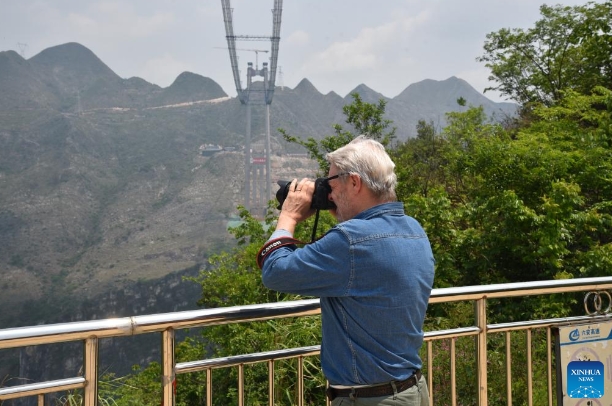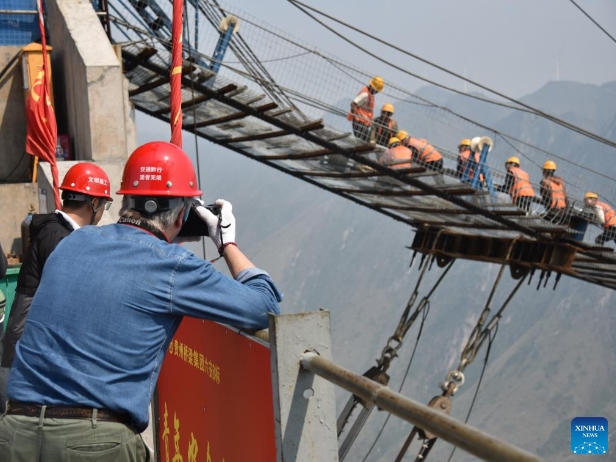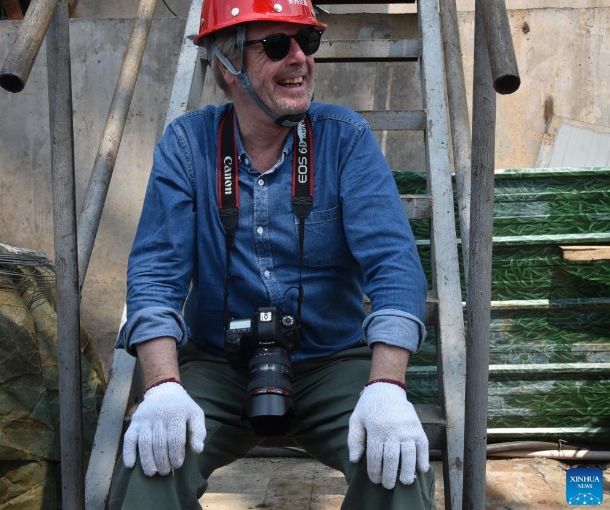French photographer finds charm of bridges in China's Guizhou

French photographer Gregoire de Gaulle takes photos at the construction site of the Huajiang Grand Canyon Bridge in southwest China's Guizhou Province, April 27, 2024. (Xinhua/Luo Fei)
Standing on the catwalk hundreds of meters high in the air, Gregoire de Gaulle felt a gust of wind whistling in his ears.
Despite the slight swaying of the catwalk, he held on to the safety rope with one hand and raised his camera with the other to photograph the bridge builders working at such height.
The 68-year-old French photographer was deeply impressed with the builders of the Huajiang Grand Canyon Bridge, a key project of an expressway in southwest China's Guizhou Province. The bridge is expected to be the world's highest, with a vertical drop of 625 meters.
Bridge builders often carry out heavy lifting operations hundreds of meters up in the air and also have to cope with harsh weather conditions including sudden rainstorms and high winds.
"The construction scene is particularly spectacular, especially these brave bridge builders. They not only have to overcome psychological factors like fear of heights, but also need to complete the bridge construction tasks well, which is particularly commendable," said de Gaulle.
This was de Gaulle's second visit to Guizhou, having recently taken part in a photo event with several Chinese photographers to tour several world-class bridges under construction in the mountainous province.
The Huajiang Grand Canyon boasts magnificent scenery, but it is also a natural barrier that hinders transport and regional development. It takes more than two hours to drive along the winding mountain road to reach the other side. Once the bridge is completed, it will take less than two minutes to cross the canyon.
China's immense investment in building world-class bridges will bring significant changes to the economic and social development of the regions along the routes, said de Gaulle.
The charm of these world-class bridges lies not only in their spectacular appearance and complex craftsmanship but also in the convenience for travel and the improvement of people's lives, he said.
Guizhou, with 92.5 percent of its land covered by mountains and hills, has been committed to eliminating transport bottlenecks. Currently, the province has built over 200,000 km of highways, with over 8,000 kilometers of expressways in operation.
Guizhou, dubbed a "bridge museum," has nearly 30,000 bridges built or under construction, including nearly half of the world's 100 tallest bridges.
While improving transport, Guizhou has also actively promoted the deep integration of transport infrastructures with tourism, injecting new vitality into the tourism sector in the province.
Liu Hao, chief engineer of the Huajiang Grand Canyon Bridge Project, said that a bridge-tourism integration demonstration project is being accelerated to build the bridge into a top-class scenic area.
The bridge-tourism integration project, which includes a 100-meter-high observation elevator, rock climbing, a scenic water bar, and a glass bridge restaurant, is a big surprise to de Gaulle.
"These plans have changed my perception of traditional bridges as pure transport facilities," he said, adding that the bridge-tourism integration will let the world have a different understanding of the construction techniques and functions of China's bridges.

French photographer Gregoire de Gaulle takes photos at the construction site of the Huajiang Grand Canyon Bridge in southwest China's Guizhou Province, April 27, 2024. (Xinhua/Luo Fei)

French photographer Gregoire de Gaulle is seen at the construction site of the Huajiang Grand Canyon Bridge in southwest China's Guizhou Province, April 27, 2024. (Xinhua/Luo Fei)
Editor:伏娅敏
